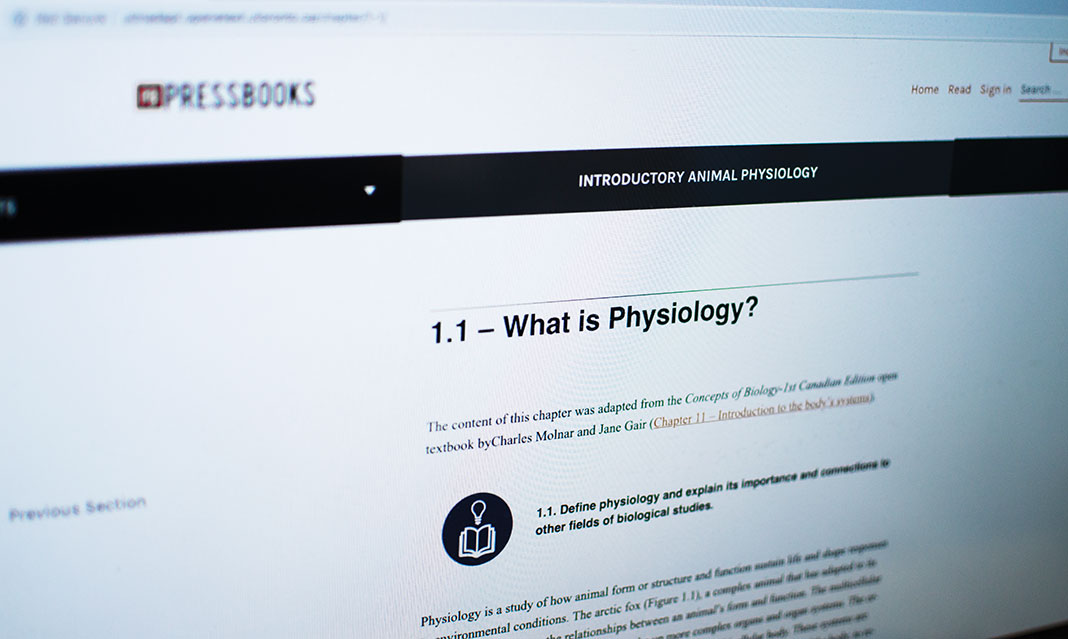While many students and families may struggle beneath the burden of expensive tuition fees, the cost of textbooks often contributes to financial stress as well. With some textbooks costing almost hundreds of dollars, students sometimes turn to borrowing textbooks from the library, renting them from the bookstore, or purchasing them from previous students at a lower cost.
For biology students enrolled in BIO202: Introductory Animal Physiology, UTM has launched their first “open access digital textbook” this month, led by assistant professor, teaching stream, Sanja Hinić-Frlog from UTM’s biology department. Students in Hinić-Frlog’s class will get their virtual textbook for free.
Frustrated by the lack of a suitable textbook for her second-year introductory animal physiology course, Hinić-Frlog explains to The Medium that she found a solution to her problem through an opportunity that arose during the summer of last year.
Hinić-Frlog was given an opportunity by eCampusOntario to develop and adapt an open resource PDF textbook tailored for her second-year biology course.
eCampusOntario, a not-for profit corporation funded by the Government of Ontario, encourages publicly funded universities and colleges to adapt or create online resources that are open and free for educational purposes and to advance learning using technology. Professors, instructors, students, textbook developers, faculty and staff are encouraged to use their resources and explore new technologies and pedagogical practices to create an effective way to learn and teach. Their mission is to provide free access to learning resources in various subject areas.
Hinić-Frlog was given a grant of $15,000 dollars to help develop a tailored textbook that would be free for use for students in her BIO202 course and anyone who would be interested in reading or using the textbook. The textbook, titled Introductory Animal Physiology, was adapted over the course of five months in collaboration with eCampusOntario, UTM’s science liaison librarian Jessica Hanley, Simone Laughton from UTM library’s IT department, undergraduate students, and graduate students from the Biomedical Communications program.
The content of the textbook was mostly developed by hired undergraduate students who also integrated various videos, interesting articles, activities, learning outcomes and images. The students were paid to put together specific content of the textbook using various free scientific resources.
Large chunks of the content were taken from different textbooks created by professors in British Columbia and other universities who have developed similar open textbook resources that had a creative commons license attribution of 4.0. The UTM librarians helped ensure that all of the content used was free for use and that permission was properly obtained.
Graduate students enrolled in the Biomedical Communications program at UTM created some of the scientific images in the textbook.
Once the textbook was developed, students taking the BIO202 course during the summer term were the first ones to test drive it and were asked to help edit and provide feedback. Currently the textbook is in full integration with BIO202 this semester. Although there is no hardcopy format alternative to the PDF textbook, students are allowed to print chapters of the textbook which may be an added cost, though very minimal compared to buying any textbook.
Hinić-Frlog has encouraged students to give feedback on the textbook and in the end will survey students experience using this textbook. As the textbook is a living document and under constant development, she hopes the content will be refined and get better over the years. A benefit to using this format is that students don’t have to wait 2-3 years or pay extra for a newer version of the textbook and that it allows instructors or faculty members to tailor or design a textbook that would fit the needs of their course. What’s different about this text is the unique approach it has in helping reinforce students’ memory and the way it allows students to effectively practice the content that is being taught in lectures, labs, and tutorials. In addition, the design of the textbook is aligned to fit the learning outcomes of the course and assessments.
According to Hinić-Frlog, not a lot of instructors have used these resources to develop open access free textbooks for courses being taught due to time constraints and funding. Developing a resource like this is very demanding and is no easy task. However, Hinić-Frlog has found that her fellow peers are very curious about the logistics of developing a project like this and encourages anyone to use these resources when given the chance. She also hopes in the future that more alternatives like these are promoted and that students are given selections between a paid option and a free resource.



